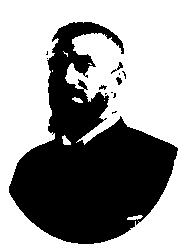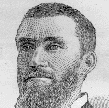

As a youth, Charles Guiteau worked in his father's business, then was employed as a cashier in Freeport's Second National Bank; however, he was unhappy in these pursuits. Luther Guiteau was very much against sending his son to college. However, in 1859, an inheritance from his maternal grandfather made it possible for Charles to attend the University of Michigan in Ann Arbor. Guiteau was unhappy at the university. For solace and direction, he turned to a religious doctrine that had been adopted by his father, known as Perfectionism, which taught that because Christ had destroyed the cause of sin, belief made sin impossible. This doctrine was taught by John Humphrey Noyes, who founded the Oneida Community in upstate New York in the 1840s, to live out a kind of "Bible communism" that embraced holding all things in common, including marriage.
In 1860, Charles Guiteau joined the Oneida Community in New York. Still unhappy, he then left the community in April 1865, convinced that he had been chosen by God to spread Noyes' self-named "millennial communism" by founding a daily newspaper. His attempt to start a paper, called the "Daily Theocrat," was unsuccessful, and in July 1865 he applied to reenter the Oneida Community. Then, just over a year later, he again quit, in November 1866, taking with him some money that he had previously given the community.
By August 1867, out of money, Guiteau sought out his sister Frances, who had raised him after the death of his mother. She was to provide him often with both moral and financial support throughout his life. Her husband offered Guiteau a job in his law office in Chicago, as well as a place to live. However, after a few months, the latter quit his position and returned to New York, ostensibly to work for Henry Ward Beecher's newspaper, the "Independent." Guiteau was soon disappointed to find that there were no editorial jobs available at the "Independent," and he ended up selling subscriptions and advertisements on commission.
Increasingly unhappy in his situation and depressed for his future prospects, Guiteau decided to sue the Oneida Community on a trumped up charge of withholding payment for the work he had performed there. For a few months, Guiteau sent threatening letters to Noyes that amounted to blackmail. Eventually, he desisted, when Oneida's lawyers threatened to prosecute him for extortion.
In 1868, Guiteau left New York and returned to Chicago, where he obtained a job as a clerk in a law office. He managed to pass the Illinois bar and set up a small private law office on his own. In 1869, he married a librarian from the local Y.M.C.A. that he frequented. Predictably, the marriage was an unhappy one. Guiteau's business was meager, and as an attorney he was mediocre and disorganized. He was abusive to his wife, reportedly locking her in a closet for whole nights. Following the Chicago fire, they moved to New York, where in 1874 she divorced him.
The following year, Guiteau's behavior became increasingly erratic. He failed to obtain funding to buy another newspaper, and was forced to move into his sister's home once again. One day, Frances reported that her brother had gone out to chop wood. When she approached him, he threatened her with the ax. She ran for the doctor, who examined Guiteau and declared that she should have him institutionalized. But Guiteau would not cooperate. He fled from his sisters house and was not heard of again for some time. In 1876, he resurfaced as a regular attendant of Dwight Moody's revivalist meetings. From 1877 to 1880, Guiteau himself became an itinerant preacher, writing and disseminating his own sermons.
In 1880, the year that his father died, Guiteau died turned to politics, having been, since childhood, an avid reader of Horace Greeley's "New York Tribune," and an early convert to Republicanism. Later, Guiteau became fired by the Republicans' intraparty conflict between the "Stalwart" faction led by Roscoe Conkling and the "Half-Breeds" led by James G. Blaine who supported then president-elect James Abram Garfield. Initially, Guiteau favored the Stalwarts and their attempt to nominate Ulysses S. Grant for a third term. When Garfield was nominated, however, Guiteau changed sides. He soon became a familiar figure stationed outside Republican headquarters on Fifth Avenue in New York City. Here, on August 6, 1880, he delivered his speech, "Garfield vs. Hancock." After Garfield's election, in 1881, Guiteau moved to Washington, D.C., in the hope of an appointment. He bombarded Secretary of State James G. Blaine with letters. Finally, after receiving either rebuff or no response at all, Guiteau again changed sides to the Stalwarts' cause.
In mid-May 1881, he conceived the idea to "remove" the president. On June 16, 1881, he delivered the first of several "explanations" for his action, an "Address to the American People." In case circumstances did not permit his doing so after the event, he also wrote a letter to the White House and a similar one to be sent to General William T. Sherman, stating, "I have just shot the President...His death was a political necessity. I am a lawyer, theologian and politician. I am a Stalwart of the Stalwarts..."
Guiteau stalked President Garfield for some time. On July 2, 1881, he shot the President, as he was about to depart for a vacation from the Baltimore and Potomac Railroad Station, after first having taken the precaution of hiring a cab to take him to the jail so that he would not be mobbed by the crowd. Garfield, shot once in the arm and once in the back, did not immediately die but lingered until September 20th, helped along by his doctors and the state of medical knowledge at the time.
Guiteau's trial lasted from November 14, 1881, until May 22, 1882. Chief defense counsel was Guiteau's sister's husband, George Scoville, who was not a criminal lawyer and would not have taken the case had a viable alternative presented itself. The case was a landmark in that it entailed a plea of insanity, which was heartily supported by neurologists, members of the Guiteau family, and the defendant's own behavior during the trial. Guiteau made a spectacle of himself repeatedly throughout the trial, calling out abusive comments towards his attorneys, alternately haranguing and addressing the audience, complaining to the judge, and making speeches to the press. At one point Guiteau leaped to his feet and pursued the unfortunate Scoville across the courtroom, crying out, "You are no criminal lawyer. I can get two or three first-class criminal lawyers in America to manage this case for me." The bailiffs held him down and perhaps thumped him a little, so that he shouted at them, "Mind your own business! Mind your own business!" The question of whether or not an insanity plea was valid in the case of assassination would take another century to decide. However, an examination of the case in the 1960s by a psychiatrist led to a diagnosis of a mild schizophrenia.
On January 23, the jury deliberated for less than an hour before sending Guiteau to the gallows. After the sentencing, he tried to cash in on his new-found celebrity. He tried to sell the suit he shot Garfield in for $100; he sold his autographs or autographed pictures ($9 a dozen, advertised in local newspapers). On June 30, he awoke to be led to his death. He requested the flowers doubtlessly sent by his legions of admirers be sent to his cell, only to be told there were none. He recited a poem while standing before the gallows, which was long and repetitious, but boiled down to: I am going to the Lordy, I am so glad/ I am going to the Lordy, I am so glad/ I am going to the Lordy, I am so glad, etc.
 Guiteau,
from a contemporary engraving
Guiteau,
from a contemporary engraving
Sources:
"Guiteau Head in That Noose." History House
Stories. 31 Dec. 1999.
Clark, James C. The Murder of President Garfield:
The President's Last Days and the Trial and Execution of His Assassin.
Jefferson,
NC: McFarland & Company, 1993; Rosenberg, Charles E.
The Trial of
the Assassin Guiteau: Psychiatry and the Law in the Gilded Age.
Chicago, IL: University of Chicago Press, 1968; Hayes, H.G., and Hayes,
C.J. A Complete History of the Trial of Charles Julius Guiteau, Assassin
of President Garfield. Philadelphia, PA: National Publishing Company,1882;
"Charles Guiteau Collection." Lauinger Libray, Georgetown University:
Special Collections Divison. 31 Dec. 1999.
The papers of the assassin of President
Garfield are on display in the Georgetown University Special Collections
department. They are described
and indexed on Internet, along with his
life story.
Also see James
Garfield: How Alexander Graham Bell helped kill the President